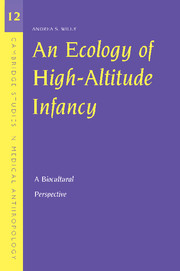Book contents
- Frontmatter
- Contents
- List of Figures, Photographs, and Tables
- Acknowledgments
- Abbreviations
- Glossary of Ladakhi Words
- An Ecology of High-Altitude Infancy
- 1 Introduction
- 2 Challenges of High-Altitude Living
- 3 Contextualizing Reproductive Health Research in Ladakh
- 4 Big Mountains, Small Babies
- 5 An Ecology of Infancy in Ladakh
- 6 Comparative Perspectives on Reproductive Health in Ladakh
- 7 Toward Relevant Research: Adaptation and Policy Perspectives on Maternal-Infant Health in Ladakh
- Notes
- References
- Index
- Titles in the series
5 - An Ecology of Infancy in Ladakh
Published online by Cambridge University Press: 18 December 2009
- Frontmatter
- Contents
- List of Figures, Photographs, and Tables
- Acknowledgments
- Abbreviations
- Glossary of Ladakhi Words
- An Ecology of High-Altitude Infancy
- 1 Introduction
- 2 Challenges of High-Altitude Living
- 3 Contextualizing Reproductive Health Research in Ladakh
- 4 Big Mountains, Small Babies
- 5 An Ecology of Infancy in Ladakh
- 6 Comparative Perspectives on Reproductive Health in Ladakh
- 7 Toward Relevant Research: Adaptation and Policy Perspectives on Maternal-Infant Health in Ladakh
- Notes
- References
- Index
- Titles in the series
Summary
The previous chapter documented the small average size of newborns in Ladakh and substantial variation within the population with respect to birth outcome that could be attributed, in part, to differences in maternal background and behavior during pregnancy. Size at birth is an important descriptor of birth outcome, but it is important to keep in mind that from an evolutionary perspective, birth outcome is significant insofar as it is related to fertility and mortality. Stillborn offspring and those who die before maturity potentially reduce a woman's reproductive success (fitness) because a women has at most about thirty years during which she can reproduce, and each birth takes up at least nine months and usually much more, given a period of postpartum infertility due to breastfeeding. Each premature death therefore reduces the overall number of surviving offspring that a woman can have. Therefore, if there is an association between measurable birth outcomes and early mortality risk, then those birth outcomes that are associated with reduced mortality can be considered adaptive because they increase the fitness of a woman and her offspring.
With regard to the specific case of birth outcome and infant mortality at high altitude, Haas (1980:261) has noted:
It is likely that variation in fetal growth at high altitude in the Andes is due in part to maternal phenotypic variation, which is a consequence of each woman's individual adaptation to hypoxic and nutritional stress during her period of growth…. Selection could have operated through the differential reproductive success of women who were better able to respond to high-altitude stress during their period of growth by developing an adult phenotype capable of producing relatively more viable offspring. […]
- Type
- Chapter
- Information
- An Ecology of High-Altitude InfancyA Biocultural Perspective, pp. 105 - 145Publisher: Cambridge University PressPrint publication year: 2004



